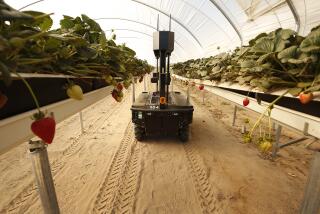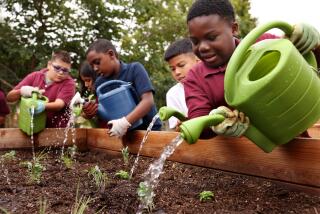Students Get Hands Dirty at Agriculture Fair
Agriculture--can you dig it?
More then 560 Camarillo Heights children certainly did Friday during a hands-on day of agriculture investigations, culminating a yearlong “Ag in the Classroom” program.
The kindergarten through fifth-grade children received tips from experts about composting, gardening and farming.
And to put things into perspective, Al Nunes, a 76-year-old retired farmer from the Santa Rosa Valley, shared stories and demonstrated antique tools from his life on the farm in the early 1900s, showing off everything from corn grinders to water pumps to a bale hook he made when he was 7 years old.
“Here’s a tool--I’ll bet none of you can guess what it was used for,” he told the eager-eyed group.
Hands shot up: to turn the television on and off when the knob’s missing, to pick coals from a fire, to brand cows.
“Nope, nope. It’s something we used to put in bulls’ noses to lead them around just like your mom leads you around by your ear,” Nunes said.
“When I was your age, when I got home from school I had to get on my horse and go out over the hills looking for cows,” he said, demonstrating the cow bells that were used on his farm and then a Portuguese brass bell used for goats and sheep.
Another trip through time occurred when Larry Lindgren, a 71-year-old Santa Paula citrus grower, revved up his 1936 John Deere orchard tractor.
After children listened to Lindgren explain how citrus trees grow to 14 feet high and have about “600 orange balls on them when they’re ready for harvest,” they learned about sheep from 4Hers Amy Compton and Michael Oberman.
“I learned what things are made out of lambs, how you hold them, how you shear them and if you make them really nervous, it will go to the bathroom,” said third-grader T.J. Smith.
Chickens managed to grab some children’s attention as well. Second-graders Tom Anderson and Sterling Granger said they learned that chickens lay different kinds of eggs, have light bones and that some eat meat.
But fifth-grader Marissa Lee found the rock demonstration really exciting, because she knew all the answers to the questions master gardener Jan Dyckes asked.
“I learned about geology in summer school,” Marissa said. “Rocks are fun to learn about because of the different types of rocks, colors and shapes. I collect them from the beach.”
Dyckes discussed how weather affects sandstone and a variety of other rocks.
“It gives them an idea of the relationship between science and agriculture,” Dyckes said. “I try to teach them that education is the greatest thing they can get because no one can ever take it away from them no matter what happens.”






